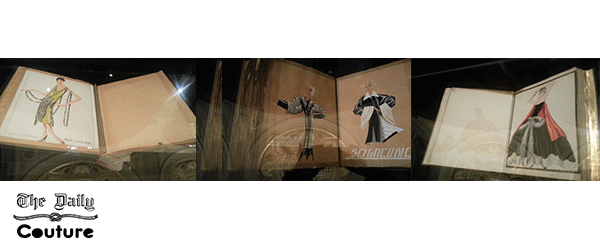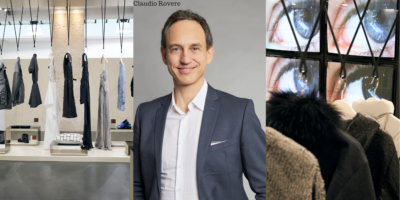In the spotlight at Palais Galliera: the art of the « couturière » Jeanne Lanvin that was showcased by a fabulous exhibition. By giving a first name and a face to what is referred today as ‘Lanvin’, one great couture brand, we get immersed in the story of a great lady of couture mostly left unknown to the wide public. In the wake of going back to the artistic heritage of the Lanvin brand, we are given the feeling to experience slow couture and master craftsmanship in all its splendor; a very distant experience of the current fashion system transformed by the success of fast fashion and our incessant quest for ever newer silhouettes leaving little room for the appreciation of materials and the virtuosity of the craftsmen of couture, these masters of detail.
While the Paris Fashion Week was going full swing and irrigated all social networks, the inauguration of the Jeanne Lanvin exhibition was inviting us to a slow fashion event by revealing details of dresses, as well as heritage pieces illustrating, among other things, the taste of the 1920s for China, Turkey or Japan and for geometrical shapes. And mostly, what is rare and impossible during a fashion show: appreciating the sensitivity of the artisans’ precise gesture very closely. Undoubtedly it remains to invent a type of event that would allow living the grandiose experience of the runway show while being able to admire the virtuosity of the savoir-faire of haute couture…
Lanvin in the time of Jeanne Lanvin
With the art of Jeanne Lanvin who opened her first shop as a milliner in 1889, we have a strange experience on this evening of the inauguration of the exhibition in 2015 immersed in the world of embroidery. Are displayed many pieces made of silk crepe, black cotton velvet, silk muslin or black silk taffeta, glass beads, half tubes or tubes, gold wire, gold thread, pearls, Swarovski crystals… Embroidered and pearled dresses, evening dresses inspired by contemporary taste for exoticism, cubism and abstraction in vogue in the 1920s, alongside dresses inspired by liturgical clothing, motifs and monastic lines.
The dresses wrapping the body like jewel armors contrast with the sobriety of some applications of pearl embroidery on the silhouettes with the « tube » line typical of Art Deco tinged with this monastic spirit. Below, the timelessly elegant « Mélisande » wedding dress in ivory chiffon is splendid, one favorite dress on display.
We are invited to feel the time spent researching, drawing and manufacturing with a display of manifold artefacts: dresses, suits, books of embroidered samples or archives preserving the illustrations of dresses painted with gouache. This experience refers to a practice of couture that has disappeared: when the couturier could draw and sew, making couture behind-the-scenes much more glamorous to discover than the approximate drawing scans often sent, today, by studios to craftspeople. With Jeanne Lanvin, the dress already keeps all its promises on paper.
The great exhibition owes much to Lanvin’s artistic direction by Alber Elbaz and to the intimate scenography by Laurence Le Bris. We owe them the boudoir spirit that perfectly evokes the practice of couture in Jeanne Lanvin’s time: we stroll through the metamorphosed space into a precious cabinet of curiosity.
The success of Alber Elbaz who have participated in reinterpreting the legacy left by Jeanne Lanvin was widelt acclaimed by the Mayor of Paris who had chosen to inaugurate the exhibition by announcing the City of Paris’ support for the fashion sector.
Do not fall asleep on your heritage, « make Paris the world’s fashion capital »
The Mayor had chosen to inaugurate the Jeanne Lanvin fashion exhibition in this museum owned by the City of Paris to announce 57 million euros dedicated to supporting the fashion sector by 2020. Anne Hidalgo wishes to make Paris « the world capital of fashion » in a world where cities compete with each other and, where Paris stands out, says Anne Hidalgo, with a history and inherited know-how of fashion.
Recognizing that the city had « fallen asleep on its heritage » until the end of the 1990s, Anne Hidalgo welcomed the « modernization of know-how » with public schools, sometimes municipal, providing quality education with accessible tuition fees.
This enthusiasm for the renewal of fashion and craftsmanship skills in the middle of Fashion Week AW 2015/2016 collections cannot however make us forget the dramatic – tragic – need to mobilize the education system to rehabilitate crafts in the education system, thus preserving the spirit of French couture. Exceptional craft trades that contribute to France’s influence in the world continue to disappear in the shadow of fiery speeches about the aura of French fashion and luxury.
La Maire avait choisi l’inauguration de l’exposition de mode Jeanne Lanvin dans ce musée appartenant à la Ville de Paris pour faire l’annonce de 57 millions d’euros consacrés au soutien du secteur de la mode d’ici 2020. Reconnaissant que la ville s’était « endormie sur son héritage » jusqu’à la fin des années 90, Anne Hidalgo s’est réjouie de la « modernisation des savoir-faire » avec les écoles publiques, parfois municipales, dispensant des enseignements de qualité et aux frais de scolarités accessibles.
Un enthousiasme devant le renouvellement des savoir-faire de la mode et des artisans en pleine semaine de présentation des collections automne-hiver 2015 /2016 qui ne peut, pourtant, faire oublier le besoin dramatique – tragique – de mobilisation du système éducatif pour réhabiliter les métiers d’art dans le système éducatif, préservant ainsi l’esprit de couture à la Française. Des métiers artisanaux d’exception contribuant au rayonnement de la France dans le monde continuent de disparaitre dans l’ombre de discours enflammés sur l’aura de la mode et du luxe français.
The promising future of Haute Couture
This issue of heritage and the preservation of craft trades is so crucial for the luxury and fashion sector that it was, let us recall, one of the action points of the former DGCIS under the former direction of the Ministry of Productive Recovery and the Ministry of Crafts, Trade and Tourism of France. Support work was set up to deal with the disappearance of craft trades. For the first time, representatives of fashion and luxury brands, industrialists, craftsmen and the government gathered together. A long-term project for which we are still waiting for some spin-offs, particularly after the Mazars Study, « Know-how in fashion and luxury: what are the challenges for the French industry? » that The Daily Couture covers here.
Meanwhile, the culture of craftsmanship is flourishing again with new creators and designers sublimating the talent of craftspeople and renewing traditional crafts. Through their unique pieces and small series, they participate in the renewal of an intimate Couture spirit. In a way, the beautiful Jeanne Lanvin exhibition echoes today’s come-back of a couture spirit, master craftsmanship and slow fashion.








